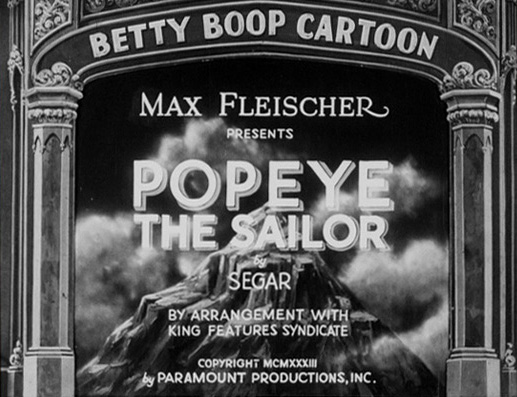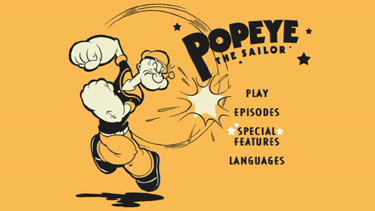![]()
![]()

![]()
![]()

directed by Dave Fleischer
USA
|
Popeye is not your typical superhero: He is old. He is bald. He is short. He only has one eye. He constantly smokes his corncob pipe. He does not have teeth. He has tattooed, bulging forearms. He is illiterate and unrefined. Yet, these oddly unique qualities have helped this simple straight-talking, hard-hitting sailor win the hearts of many generations around the world. Popeye was a true hero of his time. By the mid-1930s, he surpassed even Disney's Mickey Mouse in popularity. With his charming "I Yam What I Yam" philosophy, the one-eyed sailor proudly expressed his genuineness, integrity, and take-charge personality, which made him stand out during the Depression era. Even though he can be seen as an American hero from the past, Popeye does not necessarily need this kind of national and historical contextualization. In other words, Segar's pipe-tooting sailorman is "timeless" and "universal." His human qualities are as much to be strived for in our world of corporate globalization, media manipulations, and wars against and of terrorism, as they were during the Great Depression. Even though he is a murderer of the modern English tongue, Popeye speaks, without any problems, the transnational language of selfless bravery, relentless belief in oneself, and uncompromising adherence to one's own set of moral/ethic codes. For over 75 years now, Popeye has been breaking national and cultural boundaries, serving as a site of identification for kids and adults around the world. True, Popeye is long past his heyday. But that is due more to the corporate politics than to the passage of time or lack of public interest. There remains to be something timelessly charming about this simple, spinach-eating, pipe-smoking, unsightly underdog, who proudly remains "what he is," who takes no guff from anyone, and who is always ready to fight Bluto, that quintessential embodiment of bully-ness, to protect the girl he loves. I think that it is as easy today as it was in the 1930s to love the self-righteous, yet delightfully humble underdog who fights back "when that's all he can stands, 'cause he can't stands no more." How many of us wish we could just eat our spinach, fight back and teach all the annoying bullies in our lives a valuable lesson? In reality, that's not always possible. That's why Popeye has been doing it for all of us for three quarters of a century now. Excerpt from Gordan Calma's article "Popeye Turns 75' at fleischerpopeye.com HERE |
DVD Review: Warner Home Video (Volume 1, 1933- 1938) - Region 1 - NTSC
| DVD Box Cover |
|
CLICK to order from: |
| Distribution |
Warner Home Video Region 1 - NTSC |
|
| Runtime | 416 min | |
| Video |
4:3 Original Aspect Ratio |
|
| Audio | Dolby Mono | |
| Subtitles | English (SDH) | |
| Features |
Release Information: Studio: Warner Home Video Aspect Ratio:
Edition Details: Chapters 60 |
|
| Comments: |
The 60 shorts in this set are presented chronologically on four
dual layered discs. Each DVD holds 15 cartoons with the
supplements evenly divided.
There are a lot of cool extras on each DVD. Some early shorts by
Bray Productions produced between 1915 and 1919 are on discs one
and two including a 1916 Krazy Kat episode. On discs three and
four you'll find 10 early Fleishman "Out of the Inkwell"
cartoons. These are in addition to two well produced
documentaries and eight mini "Popumentaries" addressing the
different characters and concepts that go into Popeye. The main
documentary on Popeye, I Yam What I Yam: The Story of Popeye the
Sailor, chronicles the evolution of the series from it's
inception up to the present. It's clear from watching this that
the animation and characterization of Popeye cartoons during the
Fleishman period were a remarkable achievement that have not
been topped by any subsequent versions of this character.. |
DVD Menus
|
|
|
|
|
|
 |
 |
Screen Captures
|
|
|
|
|
|
|
|
|
|
|
|
|
|
| DVD Box Cover |
|
CLICK to order from: |
| Distribution |
Warner Home Video Region 1 - NTSC |
|
![]()
![]()
![]()
![]()
































